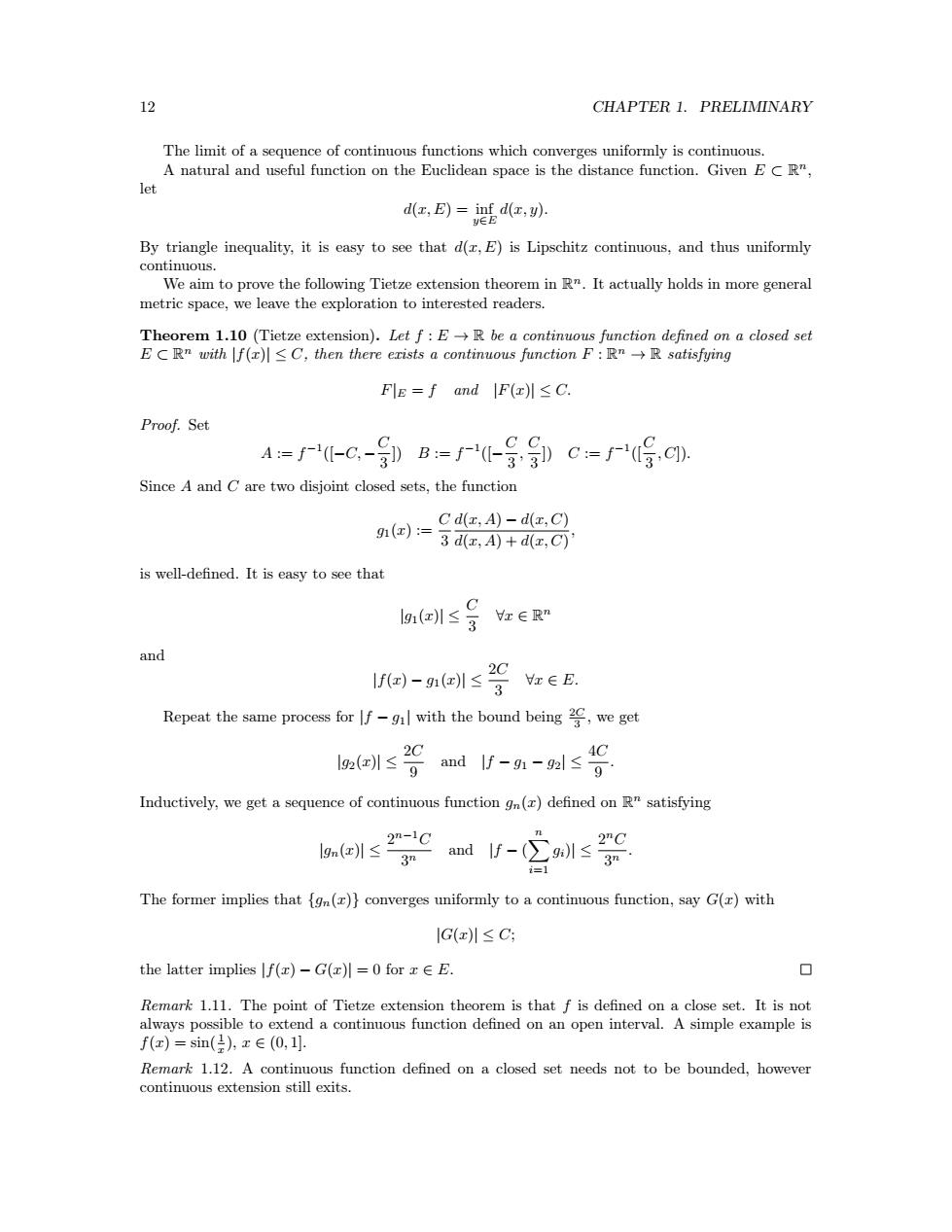正在加载图片...

CHAPTER 1.PRELIMINARY onon the dz,E)=id红, By triangle inequality,it is easy to see that d(,E)is Lipschitz continuous,and thus uniformly We aim to p rove the following tietze extension theo rem in R".It actually holds in more general Theorem 1.10(Tietze extension).Let f:E-R be a continuous function defined on a closed set ECRn with f()C,then there erists a continuous function F:R"R satisfying FE=f and F()≤C. Proof.Set A=r八-C-)B=f-)c=八写c Since A and C are two disjoint closed sets,the function =写利:8 is well-defined.It is easy to see that sm(als号zeg” and 回-n创s29z∈E. Repeat the same process for fg with the bound being2,we get loades and Inductively,we get a sequence of continuous function()defined onR"satisfying The former implies that ()converges uniformly to a continuous function,say G()with the latter implies f(r)-G()=0 for EE. 0 Remark 1.11.The point of Tietze extension theorem is that f is defined on a close set.It is not always poss ible to extend a continuous function defined on an open interval.A simple example is f(x)=sin(3),x∈(0,1 Remark 1.12.A continuous function defined on a closed set needs not to be bounded,however continuous extension still exits.12 CHAPTER 1. PRELIMINARY The limit of a sequence of continuous functions which converges uniformly is continuous. A natural and useful function on the Euclidean space is the distance function. Given E ⊂ R n, let d(x, E) = inf y∈E d(x, y). By triangle inequality, it is easy to see that d(x, E) is Lipschitz continuous, and thus uniformly continuous. We aim to prove the following Tietze extension theorem in R n. It actually holds in more general metric space, we leave the exploration to interested readers. Theorem 1.10 (Tietze extension). Let f : E → R be a continuous function defined on a closed set E ⊂ R n with |f(x)| ≤ C, then there exists a continuous function F : R n → R satisfying F|E = f and |F(x)| ≤ C. Proof. Set A := f −1 ([−C, − C 3 ]) B := f −1 ([− C 3 , C 3 ]) C := f −1 ([C 3 , C]). Since A and C are two disjoint closed sets, the function g1(x) := C 3 d(x, A) − d(x, C) d(x, A) + d(x, C) , is well-defined. It is easy to see that |g1(x)| ≤ C 3 ∀x ∈ R n and |f(x) − g1(x)| ≤ 2C 3 ∀x ∈ E. Repeat the same process for |f − g1| with the bound being 2C 3 , we get |g2(x)| ≤ 2C 9 and |f − g1 − g2| ≤ 4C 9 . Inductively, we get a sequence of continuous function gn(x) defined on R n satisfying |gn(x)| ≤ 2 n−1C 3 n and |f − ( Xn i=1 gi)| ≤ 2 nC 3 n . The former implies that {gn(x)} converges uniformly to a continuous function, say G(x) with |G(x)| ≤ C; the latter implies |f(x) − G(x)| = 0 for x ∈ E. Remark 1.11. The point of Tietze extension theorem is that f is defined on a close set. It is not always possible to extend a continuous function defined on an open interval. A simple example is f(x) = sin( 1 x ), x ∈ (0, 1]. Remark 1.12. A continuous function defined on a closed set needs not to be bounded, however continuous extension still exits